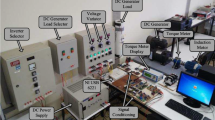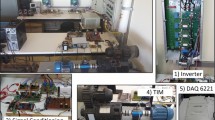Abstract
The present work proposes the study and development of a strategy that uses an optimization algorithm combined with pattern classifiers to identify short-circuit stator failures, broken rotor bars and bearing wear in three-phase induction motors, using voltage, current, and speed signals. The Differential Evolution, Particle Swarm Optimization, and Simulated Annealing algorithms are used to estimate the electrical parameters of the induction motor through the equivalent electrical circuit and the failure identification arises by variation of these parameters with the evolution of each fault. The classification of each type of failure is tested using Artificial Neural Network, Support Vector Machine and k-Nearest Neighbor. The database used for this work was obtained through laboratory experiments performed with 1-HP and 2-HP line-connected motors, under mechanical load variation and unbalanced voltage.






Similar content being viewed by others
Data availability
Enquiries about data availability should be directed to the authors.
References
Abdelwanis M, El-Sehiemy R, Hamida M (2021) Hybrid optimization algorithm for parameter estimation of poly-phase induction motors with experimental verification. Energy AI 5(100):083
Ali MZ, Shabbir MNSK, Liang X et al (2019) Machine learning-based fault diagnosis for single-and multi-faults in induction motors using measured stator currents and vibration signals. IEEE Trans Ind Appl 55(3):2378–2391
Aminu M, Barendse P, Khan A (2020) A simplified equivalent circuit method for induction machine nonintrusive field efficiency estimation. IEEE Trans Ind Electron 67(9):7301–7311
Bergman S (1970) The kernel function and conformal mapping, vol 5. American Mathematical Society, Providence
Camarena-Martinez D, Valtierra-Rodriguez M, Garcia-Perez A et al (2014) Empirical mode decomposition and neural networks on FPGA for fault diagnosis in induction motors. Sci World J 2014;908140
Černỳ V (1985) Thermodynamical approach to the traveling salesman problem: an efficient simulation algorithm. J Optim Theory Appl 45(1):41–51
Cerquitelli T, Meo M, Curado M et al (2023) Machine learning empowered computer networks. Comput Netw 230(109):807
Chapman S (2005) Electric machinery fundamentals. McGraw-Hill Companies. Inc., New York, NY, USA
Devi NR, Sarma DS, Rao PR (2016) Diagnosis and classification of stator winding insulation faults on a three-phase induction motor using wavelet and MNN. IEEE Trans Dielectr Electr Insul 23(5):2543–2555
Dhandapani R, Mitiche I, McMeekin S et al (2022) A novel bearing faults detection method using generalized Gaussian distribution refined composite multiscale dispersion entropy. IEEE Trans Instrum Meas 71:1–12
Duan F, Živanović R (2016) Induction motor stator fault detection by a condition monitoring scheme based on parameter estimation algorithms. Electr Power Compon Syst 44(10):1138–1148
Duda RO, Hart PE, Stork DG (2012) Pattern classification. Wiley, Hoboken
Elbes M, Alzubi S, Kanan T et al (2019) A survey on particle swarm optimization with emphasis on engineering and network applications. Evolut Intell 12:113–129
Ferreira C (2006) Designing neural networks using gene expression programming. In: Abraham A, de Baets B, Köppen M et al (eds) Applied soft computing technologies: the challenge of complexity. Springer, Berlin, pp 517–535
Gangsar P, Tiwari R (2019) A support vector machine based fault diagnostics of induction motors for practical situation of multi-sensor limited data case. Measurement 135:694–711
Garcia-Ramirez AG, Morales-Hernandez LA, Osornio-Rios RA et al (2014) Fault detection in induction motors and the impact on the kinematic chain through thermographic analysis. Electr Power Syst Res 114:1–9
Garner SR et al (1995) Weka: the waikato environment for knowledge analysis. In: Proceedings of the New Zealand Computer Science Research Students Conference, pp 57–64
Glowacz A (2018) Acoustic based fault diagnosis of three-phase induction motor. Appl Acoust 137:82–89
Gnanaprakasam CN, Chitra K (2017) Soft-computing based digital filter design to analyze vibration signals of induction motor. In: 2017 International Conference on Algorithms, Methodology, Models and Applications in Emerging Technologies (ICAMMAET), Chennai, India, pp 1–4
Jiang X, Xu Y, Ke W et al (2022) An imbalanced multifault diagnosis method based on bias weights AdaBoost. IEEE Trans Instrum Meas 71:1–8
Kennedy J (2010) Particle Swarm Optimization. In: Sammut C, Webb GI (eds) Encyclopedia of Machine Learning. Springer, Boston, MA
Kirkpatrick S, Gelatt CD, Vecchi MP (1983) Optimization by simulated annealing. Science 220(4598):671–680
Konar P, Chattopadhyay P (2015) Multi-class fault diagnosis of induction motor using Hilbert and wavelet transform. Appl Soft Comput 30:341–352
Li R, Zhuang L, Li Y et al (2021) Intelligent bearing fault diagnosis based on scaled Ramanujan filter banks in noisy environments. IEEE Trans Instrum Meas 70:1–13
Liu Y, Bazzi AM (2017) A review and comparison of fault detection and diagnosis methods for squirrel-cage induction motors: state of the art. ISA Trans 70:400–409
Lu S, He Q, Yuan T et al (2016) Online fault diagnosis of motor bearing via stochastic-resonance-based adaptive filter in an embedded system. IEEE Trans Syst Man Cybern: Syst 47(7):1111–1122
Lu F, Tong Q, Feng Z et al (2023) Unbalanced bearing fault diagnosis under various speeds based on spectrum alignment and deep transfer convolution neural network. IEEE Trans Ind Inform 19(7):8295–8306
Martínez-Morales J, Palacios-Hernández E, Campos-Delgado D (2018) Multiple-fault diagnosis in induction motors through support vector machine classification at variable operating conditions. Electr Eng 100(1):59–73
Miao J, Zhu W (2021) Precision-recall curve (PRC) classification trees. Evolut Intell 15(3):1545–1569
Morales-Perez C, Rangel-Magdaleno J, Peregrina-Barreto H et al (2018) Incipient broken rotor bar detection in induction motors using vibration signals and the orthogonal matching pursuit algorithm. IEEE Trans Instrum Meas 67(9):2058–2068
Motors W, Motors GP, Motors ISECI (2010) E-technical catalog
Pandarakone SE, Mizuno Y, Nakamura H (2017) Distinct fault analysis of induction motor bearing using frequency spectrum determination and support vector machine. IEEE Trans Ind Appl 53(3):3049–3056
Patel R, Giri V (2017) ANN based performance evaluation of BDI for condition monitoring of induction motor bearings. J Inst Eng (India): Ser B 98(3):267–274
Platt J (1998) Sequential minimal optimization: a fast algorithm for training support vector machines. Technical Report. MSR-TR-98-14, Microsoft
Price K, Storn RM, Lampinen JA (2006) Differential evolution: a practical approach to global optimization. Springer Science & Business Media, Berlin
Ramirez-Nunez J, Antonino-Daviu J, Climente-Alarcon V et al (2018) Evaluation of the detectability of electromechanical faults in induction motors via transient analysis of the stray flux. IEEE Trans Ind Appl 54(5):4324–4332
Ray S (2021) An analysis of computational complexity and accuracy of two supervised machine learning algorithms—k-nearest neighbor and support vector machine. In: Sharma N, Chakrabarti A, Balas VE et al (eds) Data management, analytics and innovation. Springer Singapore, Singapore, pp 335–347
Shao S, McAleer S, Yan R et al (2018) Highly accurate machine fault diagnosis using deep transfer learning. IEEE Trans Ind Inform 15(4):2446–2455
Sharma A, Jigyasu R, Mathew L, Chatterji S (2018) Bearing fault diagnosis using weighted K-nearest neighbor. In: 2018 2nd International Conference on Trends in Electronics and Informatics (ICOEI), Tirunelveli, India, 2018, pp 1132–1137
Silva INd, Spatti DH, Flauzino RA et al (2017) Artificial neural network—a practical course. Springer, Berlin
Singh J (2023) Computational complexity and analysis of supervised machine learning algorithms. In: Kumar R, Pattnaik PK, Tavares JMRS (eds) Next generation of Internet of Things. Springer Nature Singapore, Singapore, pp 195–206
Singh S, Kumar N (2017) Detection of bearing faults in mechanical systems using stator current monitoring. IEEE Trans Ind Inform 13(3):1341–1349
Soleimani M, Alizadeh MN, Moallem M (2018) Economical replacement decision for induction motors in industry. In: 2018 IEEE Texas Power and Energy Conference (TPEC), College Station, TX, USA, 2018, pp 1–6
Soualhi M, Nguyen KT, Soualhi A et al (2019) Health monitoring of bearing and gear faults by using a new health indicator extracted from current signals. Measurement 141:37–51
Sudholt D (2008) Computational complexity of evolutionary algorithms, hybridizations, and swarm intelligence. PhD thesis, Technische Universität Dortmund
Sun G, Lan Y, Zhao R (2019) Differential evolution with Gaussian mutation and dynamic parameter adjustment. Soft Comput 23(5):1615–1642
Takahashi K, Yamamoto K, Kuchiba A et al (2022) Confidence interval for micro-averaged F1 and macro-averaged F1 scores. Appl Intell 52:4961–4972
Tsuzuki MSG, Martins TC (2014) Simulated annealing: strategies, potential uses and advantages. Nova Publishers, New York
Vapnik V (2013) The nature of statistical learning theory. Springer Science & Business Media, Berlin
Wang L, Liu Y (2018) Application of simulated annealing particle swarm optimization based on correlation in parameter identification of induction motor. Math Probl Eng 2018:1869232
Wang C, Liu Y, Liang X et al (2018) Self-adaptive differential evolution algorithm with hybrid mutation operator for parameters identification of PMSM. Soft Comput 22(4):1263–1285
Wang J, Fu P, Zhang L et al (2019) Multilevel information fusion for induction motor fault diagnosis. IEEE/ASME Trans Mechatron 24(5):2139–2150
Wegener I (2002) Methods for the analysis of evolutionary algorithms on pseudo-Boolean functions. Springer US, Boston, pp 349–369
Xu B, Sun L, Li H (2013) A detection method for rotor fault in induction motors based on high frequency resolution spectrum estimation technique and optimization algorithm. In: Zhongguo Dianji Gongcheng Xuebao/Proceedings of the Chinese Society of Electrical Engineering, vol 33, pp 140–147
Yang XS (2010) Engineering optimization: an introduction with metaheuristic applications. Wiley, Hoboken
Yetgin AG (2019) Effects of induction motor end ring faults on motor performance. experimental results. Eng Fail Anal 96:374–383
Yu W, Lv P (2021) An end-to-end intelligent fault diagnosis application for rolling bearing based on MobileNet. IEEE Access 9:41925–41933
Zhang X, Song Q (2014) Predicting the number of nearest neighbors for the k-NN classification algorithm. Intell Data Anal 18(3):449–464
Acknowledgements
Authors would like to thank the financial support of the National Council for Scientific and Technological Development (CNPq) under Grant 474290/2008-3, 473576/2011-2, 552269/2011-5, 307220/2016-8.
Funding
This study was funded by Conselho Nacional de Desenvolvimento Científico e Tecnológico (Grant nos. 474290/2008-3, 473576/2011-2, 552269/2011-5, 307220/2016-8).
Author information
Authors and Affiliations
Corresponding author
Ethics declarations
Conflict of interest
The authors declare that they have no known competing financial interests or personal relationships that could have appeared to influence the work reported in this paper.
Ethical approval
This article does not contain any studies with human participants or animals performed by any of the authors.
Additional information
Publisher's Note
Springer Nature remains neutral with regard to jurisdictional claims in published maps and institutional affiliations.
Rights and permissions
Springer Nature or its licensor (e.g. a society or other partner) holds exclusive rights to this article under a publishing agreement with the author(s) or other rightsholder(s); author self-archiving of the accepted manuscript version of this article is solely governed by the terms of such publishing agreement and applicable law.
About this article
Cite this article
Guedes, J.J., Goedtel, A., Castoldi, M.F. et al. Three-phase induction motor fault identification using optimization algorithms and intelligent systems. Soft Comput (2024). https://doi.org/10.1007/s00500-023-09519-5
Accepted:
Published:
DOI: https://doi.org/10.1007/s00500-023-09519-5




